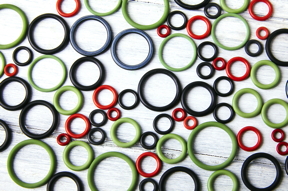Home > Press > Oil & gas and automotive sectors will benefit from durable polymers with graphene nanotubes
 |
Abstract:
Oil & gas, automotive, chemical processing and other industries that deal with the harshest heat and chemical conditions are now able to utilize high-performance fluoroelastomers with graphene nanotubes that guarantee continuous production operations with less frequent shut-downs for maintenance. A new nanotube solution has entered the market, paving the way for reducing filler content and improving polymer stability in aggressive atmospheres.
Oil & gas and automotive sectors will benefit from durable polymers with graphene nanotubes
Luxembourg | Posted on May 14th, 2020
Small, but critical, components such as seals, O-rings, gaskets, and hoses are exposed to the harshest environments in oil & gas operations or as parts of vehicle engines. Fluoroelastomers are often the top choice for these tiny rubber parts due to the requirement to resist synthetic oils, corrosive fumes, chemicals, ultra-high temperatures and pressure. Depending on the final application requirements, conductive compounds based on carbon black or reinforced formulations based on silica are two types of widely used FKM formulations for the most vital sectors.
New technology has been developed to further improve both of these FKM formulas, which can help to reduce material consumption and save maintenance costs. A solution based on TUBALL graphene nanotubes, produced by OCSiAl, allows manufacturers to enhance all mechanical properties including prolonged durability, and also provides electrical conductivity to FKM.
In carbon black-based FKM formulation, it has been proven that introducing as low as 3% of graphene nanotube concentrate can neutralize carbon blacks negative impacts on flexibility and elasticity, which otherwise result in hardening and a reduced life cycle for the final products. Nanotubes make it possible to achieve electrical resistivity of 5 Ohm*cm, and at the same time to improve tensile and tear parameters by 3040% without a reduction in elasticity, according to data after heat and fuel C aging.
In silica-based FKM, the addition of graphene nanotubes results in increased resistance to synthetic fuels and heat, improved tensile strength and M100 (or modulus 100) by up to 30%, increased abrasion resistance by up to 20% and enhanced tear strength by up to 90%. Moreover, tests have proven that these improvements to mechanical properties are maintained throughout extensive heating. Additionally, graphene nanotube-enhanced, silica-based FKMs offer electrical conductivity below 10 Ohm*cm.
These advancements of high value not only in oil & gas and auto industry, but also in some specific applications, such as in production areas with automated systems and sensors where color and electrostatics are required for identification of parts by robots.
The unique properties offered by graphene nanotubes give more freedom to FKM compounders to upgrade rubber formulations by reducing filler content and improving polymer stability in austere environments, which results in economic benefits to a number of key industries.
####
For more information, please click here
Contacts:
Anastasia Zirka
PR & Advertising Manager
+7 913 989 9239
Copyright © OCSiAl Group
If you have a comment, please Contact us.
Issuers of news releases, not 7th Wave, Inc. or Nanotechnology Now, are solely responsible for the accuracy of the content.
News and information
![]() Nexeon Appoints New Chairman May 18th, 2020
Nexeon Appoints New Chairman May 18th, 2020
Graphene/ Graphite
![]() Graphene ink may be used to fight coronavirus May 1st, 2020
Graphene ink may be used to fight coronavirus May 1st, 2020
![]() Multi-functionalization of graphene for molecular targeted cancer therapy April 24th, 2020
Multi-functionalization of graphene for molecular targeted cancer therapy April 24th, 2020
![]() OCSiAl becomes the largest European supplier of single wall carbon nanotubes with its upgraded REACH registration April 23rd, 2020
OCSiAl becomes the largest European supplier of single wall carbon nanotubes with its upgraded REACH registration April 23rd, 2020
![]() Graphene heterostructures with black phosphorus, arsenic enable new infrared detectors April 13th, 2020
Graphene heterostructures with black phosphorus, arsenic enable new infrared detectors April 13th, 2020
Possible Futures
![]() Nexeon Appoints New Chairman May 18th, 2020
Nexeon Appoints New Chairman May 18th, 2020
Nanotubes/Buckyballs/Fullerenes/Nanorods
![]() OCSiAl becomes the largest European supplier of single wall carbon nanotubes with its upgraded REACH registration April 23rd, 2020
OCSiAl becomes the largest European supplier of single wall carbon nanotubes with its upgraded REACH registration April 23rd, 2020
![]() Double-walled nanotubes have electro-optical advantages :Rice University calculations show they could be highly useful for solar panels March 27th, 2020
Double-walled nanotubes have electro-optical advantages :Rice University calculations show they could be highly useful for solar panels March 27th, 2020
![]() Groovy key to nanotubes in 2D: Why do carbon nanotubes line up? They’re in a groove March 16th, 2020
Groovy key to nanotubes in 2D: Why do carbon nanotubes line up? They’re in a groove March 16th, 2020
![]() New study presents hygroscopic micro/nanolenses along carbon nanotube ion channels March 13th, 2020
New study presents hygroscopic micro/nanolenses along carbon nanotube ion channels March 13th, 2020
Materials/Metamaterials
![]() Sustainable structural material for plastic substitute May 11th, 2020
Sustainable structural material for plastic substitute May 11th, 2020
Announcements
![]() Nexeon Appoints New Chairman May 18th, 2020
Nexeon Appoints New Chairman May 18th, 2020
Energy
![]() Transporting energy through a single molecular nanowire: Why single wires are superior to bundles May 8th, 2020
Transporting energy through a single molecular nanowire: Why single wires are superior to bundles May 8th, 2020
![]() Getting through the bottleneckA new class of layered perovskite with high oxygen-ion conductivity April 29th, 2020
Getting through the bottleneckA new class of layered perovskite with high oxygen-ion conductivity April 29th, 2020
Automotive/Transportation
![]() Atomic Force Microscopy Can Help Expand the Tire Industrys Magic Triangle April 15th, 2020
Atomic Force Microscopy Can Help Expand the Tire Industrys Magic Triangle April 15th, 2020
![]() Pathways toward realizing the promise of all-solid-state batteries March 13th, 2020
Pathways toward realizing the promise of all-solid-state batteries March 13th, 2020
![]() New catalyst provides boost to next-generation EV batteries March 13th, 2020
New catalyst provides boost to next-generation EV batteries March 13th, 2020










